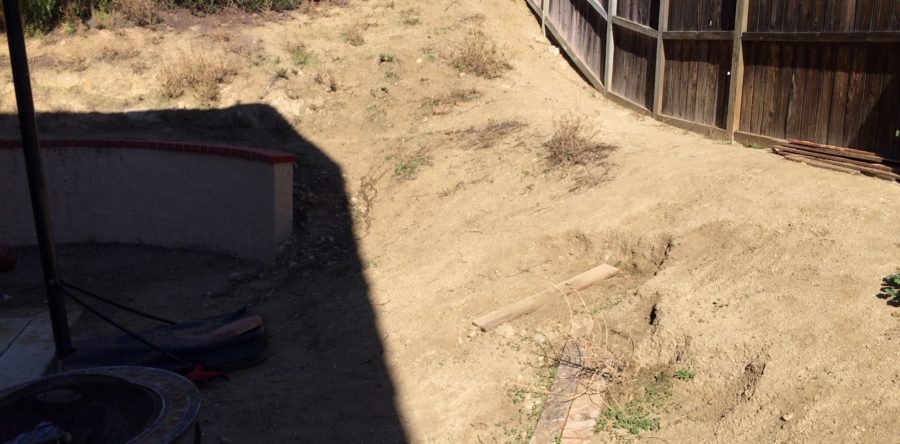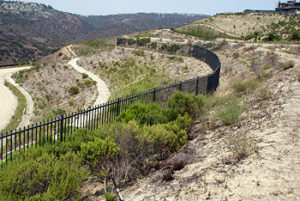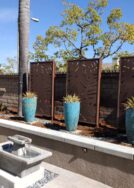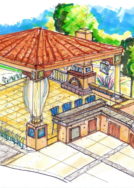Residential lots prepared for new construction in urban and rural areas often have slopes, hills, or banks one or all sides of the property. This has been the case for many years particularly in new developments and homes built in formerly rural areas throughout the western states. New homeowners are often faced with the task of maintaining plants on steep slopes and stabilizing them to control soil erosion and slope failure. Sloping terrain is mostly unsuitable property for developing without additional grading and costly retaining walls to create level ground. Planted slopes often pose a maintenance nightmare for homeowners if not designed with the correct plants suited for the climate and soil conditions, and effective at preventing soil erosion as well. The task of planting slopes is expensive, tedious, and something most homeowners want to do one time during the course of their ownership rather than every few years. For this reason it's important to know the many faces of slopes.
Slopes range from gentle natural profiles with natural vegetation to steep slippery tall banks with poor soil quality. Slopes are often graded and cut to provide level ground for new home construction. Graded slopes for new home construction often cuts through several of soil layers, known as horizons. The process often leaves little or no topsoil or vegetation in place. With new home construction, builders are required to install a minimum amount of landscape plants along with irrigation and mulch before final approval for occupancy is granted by local City or County Government. The plants are meant to reduce erosion by providing cover over exposed soil, and a root system that is effective at holding soil in place. Plants employed for this purpose consist of a combination of trees, shrubs and/or ground cover plants. Sometimes slopes can be hydro-seeded with a mixture of native wild flowers seeds suitable for slopes. These plants are usually short-lived but provide an somewhat quick and often temporary solution to stabilizing a newly graded slope. Because of the nature of slopes, allowing a slope to go unprotected for years will cause cause the loss of topsoil and eventually lead slope failure especially if burrowing animals make it their home .
There are various methods, techniques, and materials employed to stabilize and beautify slopes so that they are attractive compliment your landscape. Slopes must remain stable over a long period of time. Planting design takes into consideration the physical characteristics like; height, width, aspect, and soil type of a slope. This helps to determine the plants that are suitable and the irrigation and drainage necessary to have a successful outcome. Poor design, planning, and maintenance is most often the cause of plant failure that leads to excessive soil erosion.
CONTROLLING EROSION
Drainage systems on slopes intercept water and divert it into main drainage channels. These systems consist of engineered concrete v-ditches, culverts, and sub-surface drainage systems. Residential properties are often required to have drainage systems in place on slopes to redirect and control storm water runoff on steep terrain in developed areas.
Soil erosion is dynamic and complex in nature. It systemic in nature and has far reaching socioeconomic effects we don't realize. Left unchecked, erosion clogs drainage channels and waterways with silt. This material makes its way down stream and deposits into rivers, reservoirs, and dams. Soil erosion from private property also ends up in public streets and sewers. The cost of removing excess soil deposits costs tax payers millions to remove. A mere nuisance to most homeowners in developed nations, soil erosion is not often thought of as a worldwide problem but it is detrimental to agriculture and aquatic life. The impact of soil erosion is often felt hardest in agricultural areas where water carries away fertile soil making it necessary for farmers to use more chemical fertilizers to grow crops. These chemicals then find their way through erosion into ecosystems and create havoc.
Some soil types are more prone to erosion than others particularly in regions of high annual rainfall where vegetation has been removed by development, and also in areas that receive all their annual rainfall in a short time frame. Long periods of steady rainfall saturate slopes making them unstable, causing earth movement leading to slope failure.
Sand bags and straw filled wattles often called 'snake bags' are good temporary movable fixtures that work well to divert water and reduce erosion. These are low cost materials used during construction and landscape projects that can remain in place for an extended period of time until construction is completed or plants have grown. Hydro-spraying a slope to control erosion is a temporary solution that applies a mixture containing a material that dries firm to the touch and forms a shell that repels water .
Landscape fabric or jute mesh netting is another material use to stabilize slopes that is installed prior to planting. It is held in place with metal staples provides stability and is used in conjunction with new planting. It works great for stabilizing loose soils and will last well past the point that plants grow large enough to establish soil stability on their own.
SOIL & SLOPES
Soils vary greatly throughout regions. Generally, soils range somewhere in between sandy loose soils, to heavy clay soil. In western states sandy loam soils can be found in the valleys and along rivers terraces, with rocky soils consisting of decomposed granite on hill sides. Most often we find rocky granite type soils in the West requiring planting by jackhammer. This makes establishing permanent planting on residential slopes challenging. Some slopes may be massive in height exposing and often expose a different soil types top to bottom. Slopes are often extreme opposites from to to bottom when it comes to moisture . The upper portion usually has low moisture, and the lower portions are where water accumulates. Moisture content varies by season, but summer months in the West are the toughest on plants.
It's obviously much easier to perform work on short slightly rising slopes than steep slopes which require more labor and skill, especially if wet. Slopes are steeper than you think, tough to work on, and dangerous so instead of clawing your way up the matterhorn, consider working with a professional designer or experienced contractor.
PLANTS AND PLANTING METHODS
Plants must be compatible with your soil, climate, and irrigation or water available to the plant. Soil improvement with amendment helps plants survive the transplant period to their new home. The upper portions of a slope is often dry so as a rule select the toughest drought resistant varieties for the upper portions of the slope and those requiring more water midway to the lower portions of the slope. Considerable thought must also be given to the placement and location of plants. Depending upon the size of the slope there are several ways to grow vegetation on that bare soil. Hydro-seeding plants usually consists of annuals, perennial, and permanents shrubs. Many types of seed mixtures are available consisting of native varieties which work great in natural areas and are beneficial to birds, bees, and butterflies. This method normally requires overhead spray irrigation until seeds germinate and establish as plants. Certain wildflower plants can actually improve soil fertility while doing their job to reduce soil erosion. Once they have bloomed and are spent you can allow these plants to regenerate from their own seeds or install the additional landscape plants. When properly maintained, and allowed to regenerate, hydro-seeded natural wild flowers will last for years.
Installing container grown plants is the fastest way to get the job done. It is also the most costly solution. There are several advantages to using container plants; planting from containers is permanent, slope coverage is immediate, plants will establish more quickly, less care and maintenance than hydro-seeded areas. A small jackhammer (20 lb) with a spade attachment is invaluable for digging plant pits in tough soils. Amend the loosened soil a small amount of organic compost, organic fertilizer, (GroPower Plus), and Mycorrhizae packets, a soil bacteria that promotes root growth and expansion. These steps are key to successful planting.
Designing permanent planting for a slope also addresses plant placement to address concerns such as screening from wind and neighboring views from other homes. Generally, in western states, evergreen drought tolerant shrubs are desirable for planting on slopes because of their longevity and low maintenance. Technique for placement locates most trees in the central portion of the slope. This helps reduce the overall height or scale of especially tall slopes since they tend to dwarf the yards below, and reduces the amount of plants needed for the upper slope, reducing maintenance.
Certain trees and shrubs are more suited to life on sloping terrain than others. Generally, evergreen trees with a narrow upright cylindrical canopy or narrow vase shape canopy are best suited for slope planting. They provide good screening in groupings, withstand tough conditions, and allow sunlight to plants below. Deciduous trees may be used as well but should be limited to small flowering varieties like Crape Myrtle that provide accent color. "Lollypop" trees are least desirable. They become top heavy when mature, shade the plants below them, and require more maintenance.
Trees and plants look there best together when planted in stands, or massed together. This technique creates large swaths of texture and perennial color when in bloom . Repeating this with several types of plants will create contrast and compliment one another. Select plants that have similar care and watering needs. It's OK to experiment, but resist the urge to employ the 'one of these and one of those' approach with a myriad of varieties creating a fruit salad of effect which often leads to a maintenance nightmare.
IRRIGATION
Providing water for slope plants is usually through an irrigation system with automatic control valves and a timer. Older homes in most cases will have a high pressure overhead sprinkler system with spray heads that are fixed in place on a sprinkler riser. They spray water that covers the entire area. This system id used primarily for low growing plants that reach no higher than a couple feet. Plants higher than that will eventually end up blocking the irrigation heads and the water meant for other plants. These systems are outdated and should be converted and retro-fitted for low pressure drip irrigation
Drip irrigation is the most efficient method of irrigating slope plants. Drip systems operate under low pressure and apply water directly to the root system of plants through volume rated emitters attached to a flexible hose. These systems are controlled by a irrigation timer and often activated based on weather station information that communicates with the controller to apply water only when needed. There several types of emitters available through several manufacturers. Emitters are rated by the gallons per hour of water applied applied (GPM). A one GPM emitter will apply a gallon of water to the plant. Emitter sizes are selected based on the soil type, plant, and plant size. A plant must have a minimum of two emitters to apply water to both sides of the plant roots. A one gallon size plant may require only two emitters where a five gallon size plant needs at least three. Larger plants require more emitters of higher volume, but most often used are the one and two GPM emitter sizes. Drip irrigation hoses must be attached to the soil with metal stakes to keep the line from moving during operation.
When irrigating with a drip system on a slope, new plants are installed first, then irrigation system is installed, then the slope is mulched. Plants must be watered-in upon installation, then the drip irrigation system takes over. Watering-in plants after installation is critical to saturate the planting pit soil and root ball of the plants.
MULCHING AND MAINTAINING SLOPES
Proper maintenance is critical the first year after planting. Weed infestations unchecked in new plantings, especially on slopes, is expensive and time consuming. Beautiful slopes can easily be ruined by the lack of weed control. Weeds grow quickly, compete with plants for sun, space, nutrients, and moisture. A pre-emergent herbicide applied after planting and prior to mulching kills weed seeds and greatly reduces weed growth but do not use it in wild flower areas or natural landscapes. Your fight against weeds should include a combination of weed manual removal and light chemical herbicide application only when necessary.
Mulching provides a layer of natural decomposed organic matter over the top of the soil after planting. There are different types of mulch available. Specifically, organic mulches, are readily available in bulk amounts, inexpensive, and easy to apply. Organic mulch consists of a composted green waste, normally shredded branch material. Organic mulches are also available in redwood or cedar. They are a bit more expensive but provide a much more refined appearance. Mulch is important last process of planting a slope because it controls weed growth, maintains soil requiring less watering, and keeps soil temperatures low in the summer. Mulch also protects the irrigation hoses from exposure to sun that will deteriorate the hose over time and cause leaks. Apply at least a 2"-3" thick layer of mulch evenly over the top of the soil taking care to keep the mulch away from the base and stems of plants. Apply light mist of water over the entire area to reduce dust and to wash off plants. Mulching is by far one of the best investments you can make when planting a slope project.





